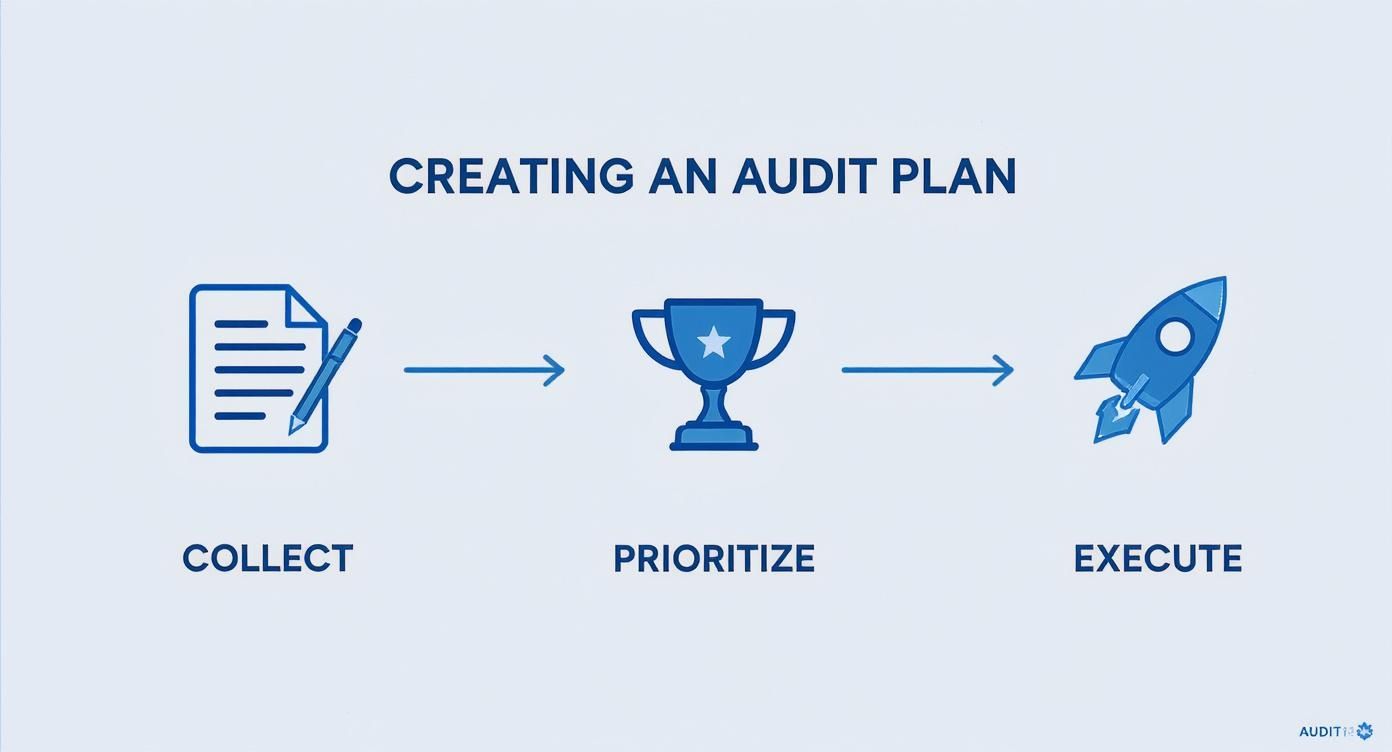
How to Perform a Website Audit for Better SEO
Share
Think of a website audit as a complete health checkup for your online storefront. It’s a deep dive into your site's technical guts, content quality, and user experience. The whole point is to find what’s holding you back—from sluggish load times to confusing navigation—and map out a clear plan to fix it. Get this right, and you'll see a real boost in both SEO and conversions.
Setting The Stage For a Successful Website Audit

Before you start running tools and building checklists, let’s get on the same page about what a website audit really does. This isn't just about spotting errors. It’s about building a strategic roadmap that turns raw data into actions that actually grow your business.
This is especially true for niche B2B industries like restaurant equipment supply, where every single qualified visitor is a potential high-value customer. You can't afford to lose them.
And you will lose them with a bad experience. In fact, up to 88% of users won't come back to a site after a single poor visit. That makes this process absolutely non-negotiable. For a more detailed look at the entire process, check out this guide on conducting a comprehensive website audit.
What Are You Trying to Accomplish?
First things first: you need clear, measurable goals. Without them, your audit will quickly turn into a messy pile of data with no purpose. So, what are you actually trying to achieve?
Maybe you want to:
- Boost organic search visibility. Your main goal might be to rank higher for critical product terms like "commercial charbroilers" or "restaurant convection ovens."
- Generate more leads. You might want to smooth out the conversion process so more chefs and restaurant owners actually fill out your quote request forms.
- Make the site easier to use. Your objective could be to slash the bounce rate on key category pages by making them more intuitive for busy professionals to navigate.
Nailing these goals down from the start keeps you focused on the changes that will make the biggest difference to your bottom line.
A good website audit is more than just a laundry list of problems—it’s a plan tied to real business outcomes. Defining your goals ensures your findings lead to tangible improvements.
Understanding the Core Pillars
A thorough website audit isn't just one thing; it's a look at your site from a few different angles. These pillars are all connected, so a weakness in one area will almost always drag the others down.
Before diving in, let's break down the essential areas you'll be investigating. Each pillar represents a critical aspect of your site's health, and understanding their individual goals will help you focus your efforts where they matter most.
| Core Pillars of a Comprehensive Website Audit |
| :--- | :--- | :--- |
| Audit Pillar | Primary Goal | Key Metrics to Watch |
| Technical SEO | Ensure search engines can crawl, index, and understand your site efficiently. | Page Speed, Index Status, Crawl Errors |
| Content & On-Page SEO| Evaluate the quality, relevance, and optimization of your content. | Keyword Rankings, Organic Traffic, Dwell Time |
| User Experience (UX)| Assess how easily and intuitively visitors can navigate and use your site. | Bounce Rate, Conversion Rate, Time on Page |
Understanding how these pillars work together is the key to a truly effective audit. After all, what good is perfectly optimized content if technical errors prevent Google from ever seeing it?
To track your progress across these areas, you'll need solid data. Setting up your analytics correctly is the first step. You can find essential guidance on our post about the importance of an analytics tracking ID. This groundwork is crucial for establishing a baseline and proving the value of your fixes down the line.
Finding and Fixing Technical SEO Bottlenecks

A solid technical foundation is completely non-negotiable for real SEO success. Think of it as the engine of your website; if it’s sputtering, even the most brilliant content and design won't get you very far. This is where we pop the hood to find out what’s holding your site back.
We’re not just hunting for glaring, obvious errors. We’re digging deeper for the silent performance killers—those small, nagging bottlenecks that add up to a massive problem for both search engines and your customers. These are the kinds of issues that can quietly sabotage your rankings if you let them.
Our goal here is to make your website clean, efficient, and dead simple for search engines to crawl. We want to make it as easy as possible for Google to find, understand, and rank your pages for valuable terms like "commercial charbroilers" or "restaurant equipment financing."
Ensuring Search Engines Can See Your Site
First thing’s first: is your site even visible to search engines? If Google can't crawl and index your pages, you're basically invisible online. This check always starts in two key places: your robots.txt file and your site's overall indexability.
Your robots.txt file is a simple text file that acts as a bouncer, giving instructions to search engine crawlers. It tells them which pages or sections of your site they should or shouldn't access. A simple typo in the robots.txt file can accidentally block Google from crawling entire product categories or all your blog posts. It happens more than you't think.
Beyond that, you have to check how individual pages are being indexed. This is often controlled by meta robots tags buried in the page's HTML. These little tags can tell search engines to "noindex" (don't show this page in search results) or "nofollow" (don't follow any of the links on this page).
This screenshot shows exactly how those meta tags appear in the code, which is what search engines actually read.

The image above gives you clear examples of noindex and nofollow directives. A huge part of any technical audit is making absolutely sure these tags aren't accidentally slapped on important pages you're trying to rank.
Mastering Site Architecture and Internal Links
Once you've confirmed search engines can get in the door, the next question is how they navigate your site. A logical site architecture is like a clear map for users and crawlers, guiding them straight to your most important content. For a restaurant equipment supplier, this means a clean structure where a user can intuitively get from the homepage to "Refrigeration," then to "Walk-in Coolers," and finally to a specific product page.
A huge piece of that structure is your internal linking. Strong internal links are what spread authority (or "link equity") throughout your site and establish a clear content hierarchy. On the flip side, broken internal links create dead ends.
These dead ends cause a few problems, none of them good:
- They waste your crawl budget. Google only allocates a finite amount of resources to crawl your site. Every time its crawler hits a broken link, that's a wasted resource that could have been spent on a real page.
- They stop the flow of authority. A link from a powerful page to another passes value. A broken link stops that value transfer cold.
- They frustrate users. Nothing kills a sale faster than a potential customer clicking a link for "charbroiler accessories" only to land on a 404 error page.
Tools like Screaming Frog are your best friend here. They crawl your entire site to find broken links (404 errors) and improper redirects (like 302 temporary redirects where a 301 permanent one is needed). Fixing these is a quick win that immediately boosts your site’s health.
Think of your website’s structure like the layout of a physical store. If the aisles are clearly marked and products are easy to find, customers will have a good experience. If the layout is chaotic and leads to dead ends, they’ll just leave.
Prioritizing Speed and Mobile Experience
Finally, no technical audit is complete without a serious look at site speed and mobile-friendliness. These aren't just "nice-to-haves" anymore; they are core parts of user experience and are heavily weighted in Google's ranking algorithms.
A slow-loading page is a conversion killer. If a chef is trying to look up specs for a new convection oven on their phone between services, they won't wait more than a few seconds for the page to load. Your audit has to use tools like Google PageSpeed Insights to pinpoint what's slowing you down, whether it's massive image files, bloated code, or a slow server.
The focus on mobile is especially critical. With 63.31% of all web traffic now coming from mobile devices, it’s easy to see why 64% of SEO marketers view mobile optimization as a top investment. As Digital Silk’s digital marketing trends show, a proper website audit must confirm that your site not only works on a phone but provides a seamless, fast experience. Nailing these technical elements turns your site from a potential liability into a powerful asset.
Auditing Your Content and On-Page SEO
Fixing the technical guts of your website gets search engines to the door, but it's your content that invites them inside and convinces them to stay. After you've sorted out the technical SEO side of things, the next phase of your website audit is to put every single piece of content under the microscope. This is where you really start evaluating its quality, relevance, and on-page optimization.
For a specialized business like a restaurant equipment supplier, this step is absolutely critical. You aren't just selling products; you're selling solutions to complex business needs. Your content has to answer very specific questions from chefs, restaurant owners, and food service managers—guiding them from a broad query like "best commercial oven" all the way to a specific product page for a high-performance charbroiler.
Taking Inventory of Your Content Assets
First things first, you need to create a complete content inventory. This sounds daunting, but it’s really just a systematic process of listing out all your indexable pages—think product pages, blog posts, buying guides, and category pages. Your goal is to pull all of this data into a single spreadsheet.
Tools like Screaming Frog are perfect for exporting every URL on your site. Once you have this raw list, you’ll enrich it with key performance metrics from Google Analytics and Google Search Console. You'll want to add columns for things like:
- Organic Traffic: How many visitors does this page actually get from search?
- Keyword Rankings: What specific terms is this page ranking for?
- Bounce Rate: Are users hitting the page and leaving immediately?
- Conversion Rate: Does this page contribute to leads or sales?
This data-driven inventory lets you start categorizing your content. You’ll quickly spot your star performers, the underachievers that get traffic but don’t convert, and the "ghost pages" that get no traffic at all. This process shines a light on which content needs to be updated, consolidated, or simply deleted.
Analyzing On-Page SEO Fundamentals
With your content inventory in hand, you can start digging into the on-page elements for individual pages. These are the direct signals you send to Google about what a page is about. They are the absolute foundation of good search visibility and are often the source of some quick wins.
For a deeper dive, check out our complete guide on what is on-page optimization.
During your audit, check these core components:
- Title Tags: Is your main keyword near the beginning? Is the title compelling enough to actually earn a click in the search results?
- Meta Descriptions: While not a direct ranking factor, a good meta description acts like ad copy, encouraging users to click. Does it accurately summarize the page and include a call-to-action?
- Header Structure (H1, H2s): Is there one, and only one, H1 tag on the page? Do the H2s and H3s logically break up the content and include relevant subtopics?
Think of your on-page SEO elements as the signposts for your content. A clear H1 tells Google the main topic, while well-structured H2s act as chapter headings, making the content easier for both users and search engines to understand.
Matching Content to User Intent
One of the most common reasons content fails is a mismatch between what you’ve written and what the user was actually looking for. This is called user intent. Someone searching for "commercial charbroiler reviews" is in a completely different mindset than someone searching for "buy Southbend P32N-CCC charbroiler."
Your audit has to diagnose this. Look at the keywords a page is ranking for. Do they align with the content on that page? If your product page for charbroilers is ranking for a bunch of informational queries, you might have a content gap. This is a huge opportunity to create a new blog post or buying guide that specifically targets those informational searches, which can then link back to your product page.
This is also where you need to check for keyword cannibalization. This happens when multiple pages on your site are competing for the same keyword, which just ends up confusing Google and diluting your authority. For example, if you have three different blog posts all trying to rank for "how to clean a commercial griddle," it's likely that none of them will rank well. Your audit should flag these instances so you can consolidate them into one authoritative piece.
An audit also reveals where you need to invest in new content. For restaurant equipment suppliers, this means more than just product pages. Effective strategies include crafting detailed blog posts that answer common customer questions, engaging in blogger outreach to build authority, and ensuring all copywriting is tailored to your professional audience.
Ultimately, auditing your content is about ensuring it directly serves the user’s needs at every single stage of their journey.
Analyzing User Experience and Site Accessibility

You can have a site that’s technically flawless and stuffed with killer content, but if it frustrates your visitors, it's fundamentally broken. This is where the audit pivots from pleasing search engine crawlers to serving the real people who land on your pages. User experience (UX) is all about walking in their shoes and smoothing out any bumps that stop them from converting.
Think about a restaurant equipment supply website. A busy chef needs to find the specs for a new charbroiler fast. A restaurant manager needs to request a quote for a walk-in cooler without a headache. A clunky, confusing site doesn't just annoy them; it actively costs you money. In fact, a bad experience will drive away 88% of users for good.
Auditing the User Journey and Navigation
First things first, you need to map out the common paths people take on your site. How does someone get from your homepage to a specific product, and then to a contact form or the checkout? The goal here is to spot any confusing steps, dead ends, or needless clicks.
Your site's navigation is the backbone of the entire experience. For an equipment supplier, this means dead-simple categories like "Cooking Equipment," "Refrigeration," and "Warewashing," with subcategories that make perfect sense.
Here are a few things I always check:
- Navigation Clarity: Are the menu labels obvious? "Commercial Ovens" is way better than a vague term like "Heating Solutions." Keep it simple and predictable.
- Call-to-Action (CTA) Effectiveness: Can visitors easily find the "Request a Quote" or "Add to Cart" buttons? They should pop off the page, using contrasting colors to grab attention.
- Internal Search Functionality: Test your search bar. If a customer types in "Southbend charbroiler," they should get exactly that, not a jumble of unrelated items.
After you've walked through the user's journey and pinpointed the pain points, you can start making real improvements. This guide has some great tips and strategies to improve website user experience that can help turn your findings into fixes.
The Growing Importance of Web Accessibility
A great user experience has to be an inclusive one. Web accessibility just means designing your site so people with disabilities can use it, too. This isn't some niche, check-the-box task anymore; it’s a core part of modern web design and a non-negotiable part of any serious audit.
Making your site accessible opens it up to a wider audience and, increasingly, search engines are seeing it as a positive ranking signal. Ensuring a site is navigable with a keyboard, provides descriptive text for images, and has proper color contrast is a huge differentiator in today's market.
An accessible website is simply a more usable website for everyone. Clear color contrast helps users in bright sunlight, not just those with visual impairments, and logical keyboard navigation benefits power users as well.
How to Test for Accessibility Issues
You don't have to be an expert to catch the most common accessibility blunders. As you go through your audit, run these simple checks to see how your site stacks up.
| Accessibility Check | What to Test | Why It Matters |
|---|---|---|
| Keyboard Navigation | Try navigating your entire site—menus, forms, everything—using only the "Tab" key. You should see a clear visual outline. | Users with motor disabilities often rely on keyboards or other devices instead of a mouse to get around. |
| Color Contrast | Use a free online tool to check the contrast between your text and background colors, especially on buttons and links. | Low contrast makes text hard or impossible to read for users with visual impairments, like color blindness. |
| Alt Text for Images | Check your images to make sure they have descriptive alt text. This text should explain what the image shows. | Screen readers use alt text to describe images to visually impaired users, giving them crucial context they'd otherwise miss. |
Running these checks gives you a solid foundation for a more inclusive website. When you prioritize both UX and accessibility, your audit goes beyond just technical fixes and helps create an online experience that works for every single potential customer.
Turning Your Audit into an Actionable Roadmap
An audit's real value isn't in the data it collects, but in the action it inspires. You've dug through the trenches, unearthing technical bottlenecks, sizing up your content, and analyzing how real people use your site. Now it's time to turn that mountain of raw data into a prioritized, effective plan that actually drives change.
Without this next step, your audit is just a fancy document. But with a clear plan, it becomes a powerful roadmap for making tangible improvements to your website. The goal is to move methodically from analysis to execution, arming your team with a data-backed plan everyone can understand and act on.
Categorizing Your Findings
First things first: you need to make sense of everything you've found. The best way to avoid getting overwhelmed is to organize your findings into logical buckets. This helps you see the bigger picture and spot patterns. Every single issue you’ve identified, from a pesky broken link to a confusing call-to-action, will fall into one of these core categories.
-
Technical SEO: This is the nuts and bolts of your site's health and crawlability. Think crawl errors, sluggish page speed, broken redirects, and indexing problems. These are often the foundational issues that need to be buttoned up first.
-
Content & On-Page SEO: Here, you'll group everything related to your content's quality and optimization. This bucket is for pages with thin content, keyword cannibalization issues, missing meta descriptions, and any content gaps you've spotted.
-
User Experience (UX) & Accessibility: This is all about the issues that impact how a visitor interacts with your site. It covers confusing navigation, poor mobile responsiveness, weak CTAs, and accessibility barriers like low color contrast.
By sorting every finding into these groups, you can start connecting the dots. Maybe you'll discover that most of your problems are technical, or that your biggest weakness is a clunky user journey on mobile devices. This high-level view is critical for what comes next.
Prioritizing Based on Impact and Effort
Okay, your findings are organized. Now you have to decide what to tackle first. Trying to fix everything at once is a surefire recipe for disaster.
The most effective method for this is the Impact/Effort Matrix. This simple framework helps you rank tasks by weighing their potential positive impact against the amount of effort (time, resources, cost) it'll take to get them done.
Think of it like this: resolving a site-wide indexing problem that's blocking Google from seeing half your product pages is a high-impact, high-priority task. On the other hand, updating the alt text on a few minor blog images is a low-impact, low-effort task.
Your audit roadmap shouldn't be a simple to-do list; it should be a strategic document. Prioritizing fixes based on impact ensures you’re always working on the changes that will deliver the most significant return for your business first.
Let's break down how this matrix helps you plan your attack. A simple table can make this crystal clear, helping you decide where to focus your energy for the best results.
| Audit Finding Prioritization Matrix |
| :--- | :--- | :--- | :--- |
| Priority Level | Impact | Effort | Example Tasks |
| 1. Quick Wins | High | Low | Fixing broken internal links, updating critical meta descriptions, correcting a robots.txt error. |
| 2. Major Projects | High | High | A complete mobile site redesign, migrating to a faster server, a large-scale content consolidation project. |
| 3. Fill-In Tasks| Low | Low | Correcting minor typos, updating alt text on non-critical pages, adding internal links to old blog posts. |
| 4. Reconsider | Low | High | A complete rewrite of low-traffic blog posts, major design changes on pages with low conversion impact. |
This matrix immediately clarifies your path forward. You should knock out the Quick Wins first to build momentum and show immediate results. Then, you can start planning the Major Projects that require more resources, while sprinkling in the Fill-In Tasks whenever you have a spare moment.
Building the Roadmap and Assigning Tasks
With your priorities locked in, the final step is to build the formal roadmap. Most teams do this in a project management tool like Asana or even a detailed shared spreadsheet. For each issue you've identified, your roadmap needs to include:
- The Specific Task: A clear description of the problem (e.g., "404 errors found on the Commercial Ovens category page").
- Priority Level: The ranking from your Impact/Effort matrix (e.g., High).
- Owner: The person or team responsible for the fix (e.g., John - Developer).
- Deadline: A realistic timeline for getting it done.
- Status: A way to track progress (e.g., Not Started, In Progress, Complete).
This structured approach transforms your audit from a static report into a living, breathing project plan. It creates accountability and ensures every valuable insight you've gathered leads to a concrete action.
As you start checking tasks off the list, it's essential to monitor your progress. Learning how to measure SEO performance will allow you to track the direct impact of your changes, proving the value of the audit and guiding your future optimization efforts.
Website Audit Frequently Asked Questions
Even with the best game plan, questions always come up when you start digging into a website audit. Let's walk through some of the most common ones I hear so you can get started with confidence.
How Often Should I Perform a Website Audit?
For a full, deep-dive audit, I recommend doing one annually. This gives you a comprehensive look at your site’s health and helps you map out a smart strategy for the year.
But you definitely shouldn't let things slide for a whole year. It’s a good practice to run smaller, more focused health checks every quarter, or even monthly. These mini-audits are perfect for keeping an eye on core vitals like site speed, any crawl errors popping up in Google Search Console, and how your most important keywords are performing. These checks should also review your local citations and link-building efforts from blogger outreach.
And one thing is non-negotiable: always run an audit right before and right after any major site changes. Think redesigns or a platform migration. This simple step can save you from a world of hurt and prevent those dreaded, unexpected traffic drops.
What Are the Best Free Tools for a Website Audit?
You'd be surprised how much you can uncover without spending a single dollar. There are some fantastic free tools out there that give you more than enough data to get a really solid audit off the ground.
- Google Search Console: This is your direct line to Google. It's absolutely essential for seeing your site the way the search engine does, finding technical snags, and tracking your search performance. You can't do a real audit without it.
- Google Analytics: This is where you learn about your visitors. It’s crucial for understanding user behavior, figuring out which pages are actually popular, and seeing how well you’re hitting your conversion goals.
- Screaming Frog: The free version lets you crawl up to 500 URLs, which is a lifesaver for smaller sites. It's my go-to for quickly spotting broken links, redirect chains, and all sorts of on-page SEO issues.
- PageSpeed Insights & Lighthouse: These are Google's own tools for diagnosing performance problems and checking on things like accessibility. A must-have for making sure your site is fast and user-friendly.
Once you’ve pulled data from these tools, you need a process to turn it into action. This infographic lays out a pretty good flow.

As you can see, the real work isn't just collecting the data. It's about prioritizing your findings and actually getting the fixes implemented.
What Is the Most Common Website Audit Mistake?
The single biggest mistake I see, time and time again, is getting completely buried in data without ever creating a real, actionable plan. It's easy to generate a massive spreadsheet full of hundreds of tiny issues, but it's much harder to step back and prioritize what actually matters for the business.
A successful audit isn't about finding every tiny flaw; it's about identifying the highest-impact problems and creating a clear, prioritized roadmap to fix them. Without a plan, an audit is just an academic exercise.
You have to focus on the things that will move the needle. Seriously. Fixing one critical indexing error that's hiding a whole section of your site from Google is infinitely more valuable than correcting a hundred typos on pages nobody visits. Always, always tie your findings back to your main business goals.
At Charbroilers.com, we understand that a high-performing website is just as essential as quality kitchen equipment. Whether you're looking for countertop, modular, or floor model charbroilers to perfect your menu, our extensive selection is designed to meet the needs of any restaurant or diner. Explore our top-tier commercial charbroilers at https://charbroilers.com and give your customers the smoky, char-grilled flavor they crave.
